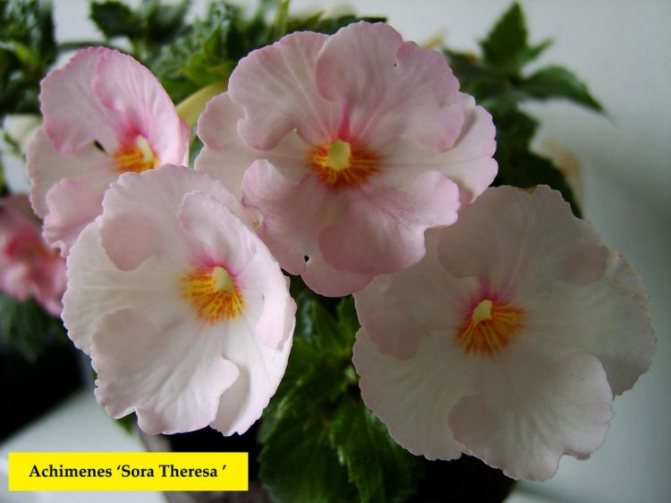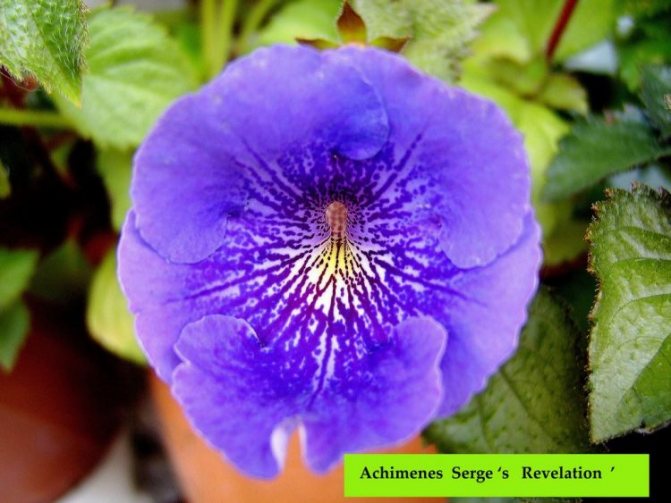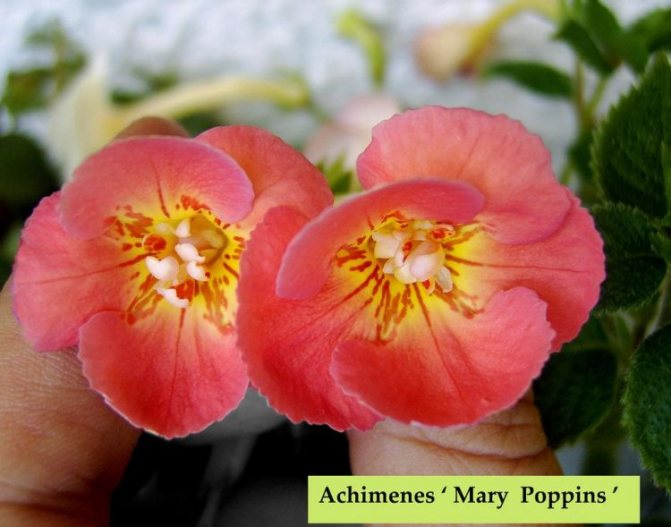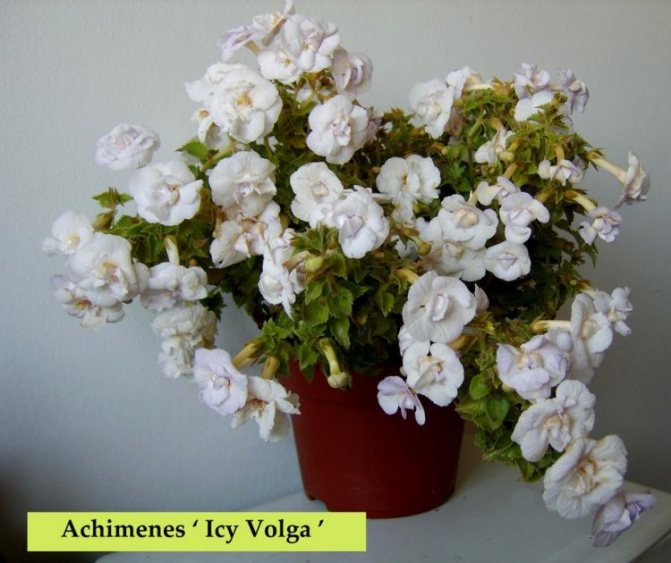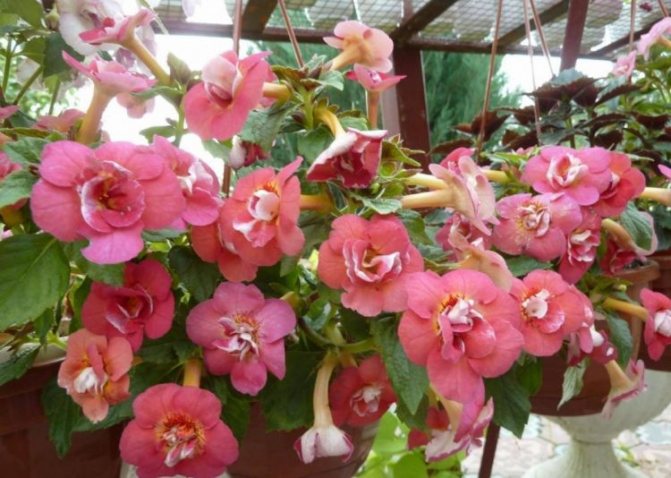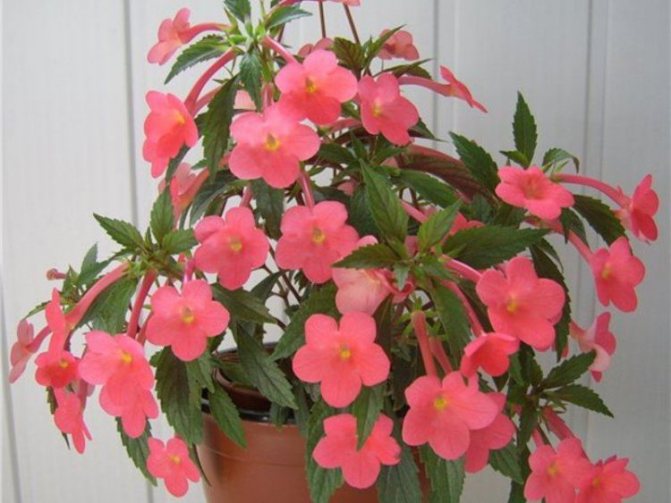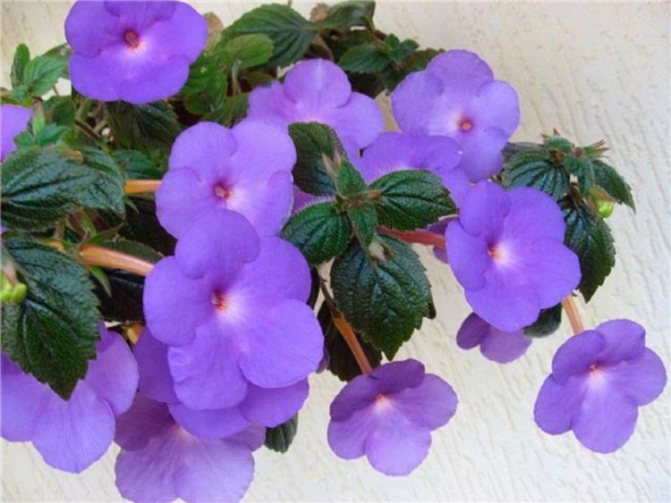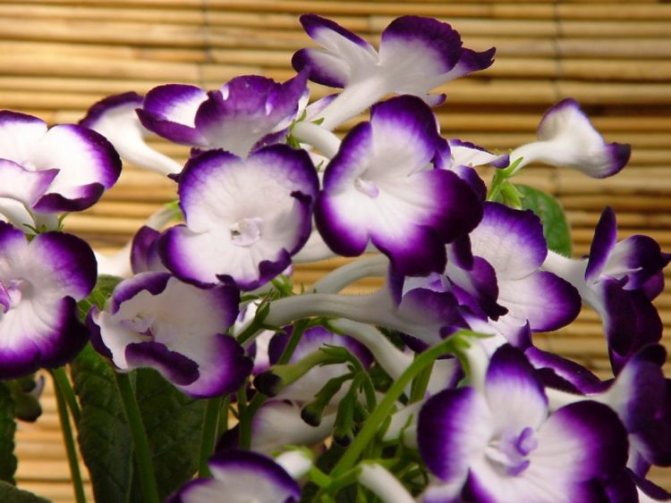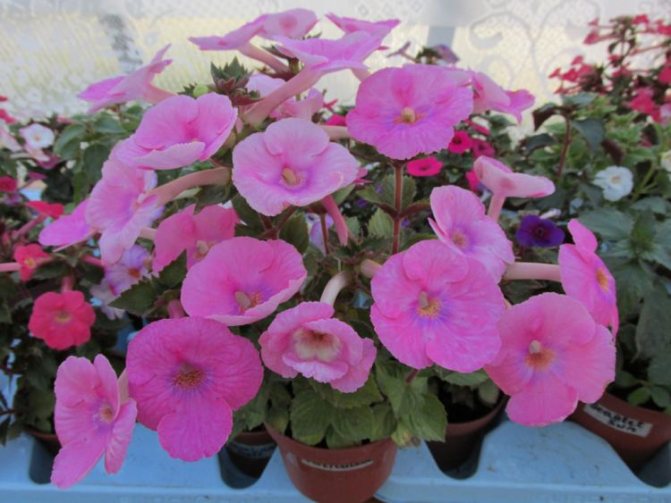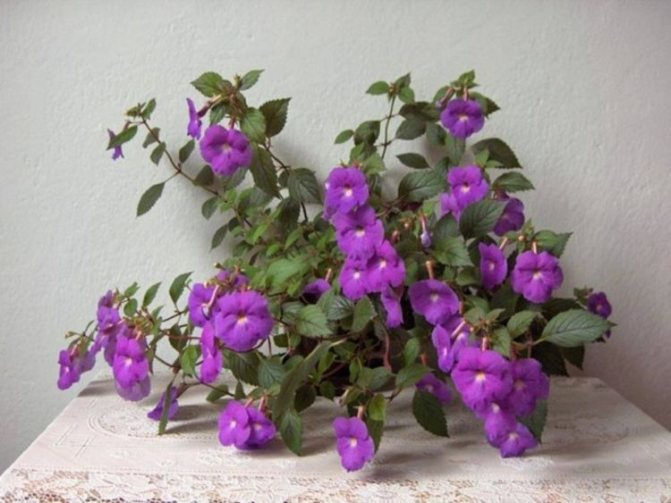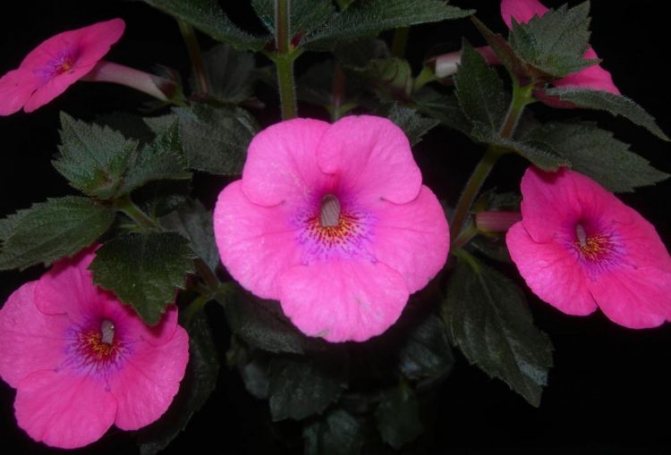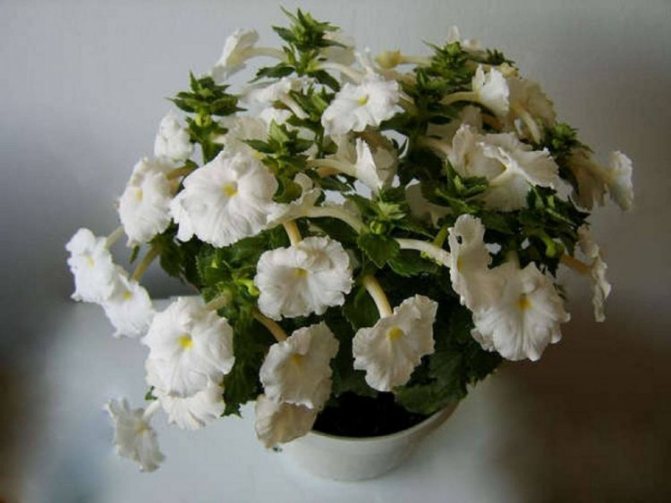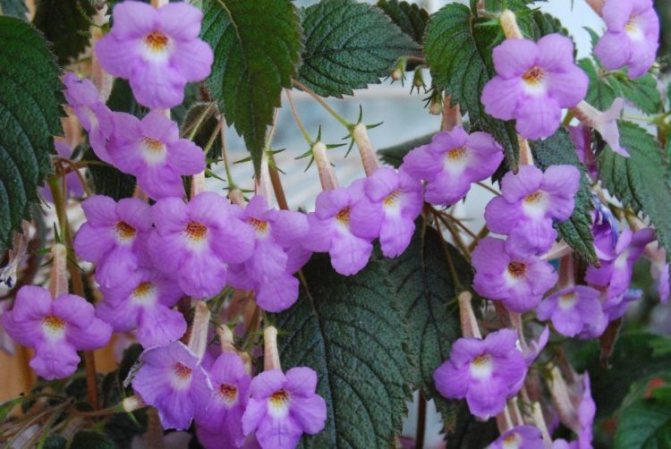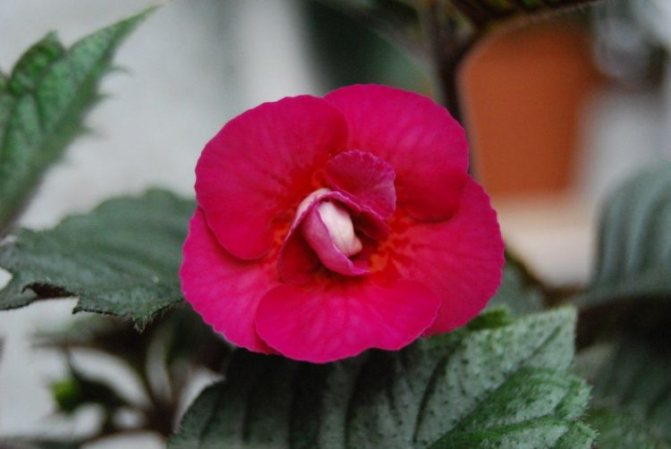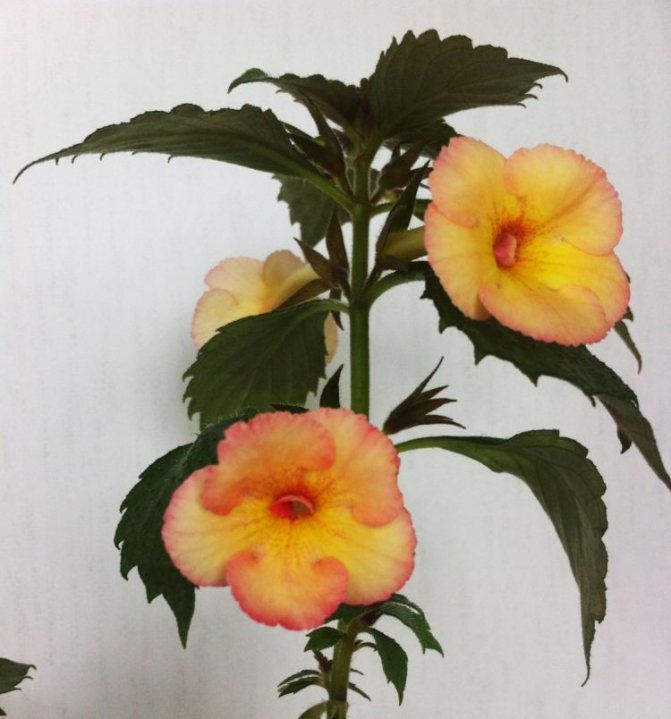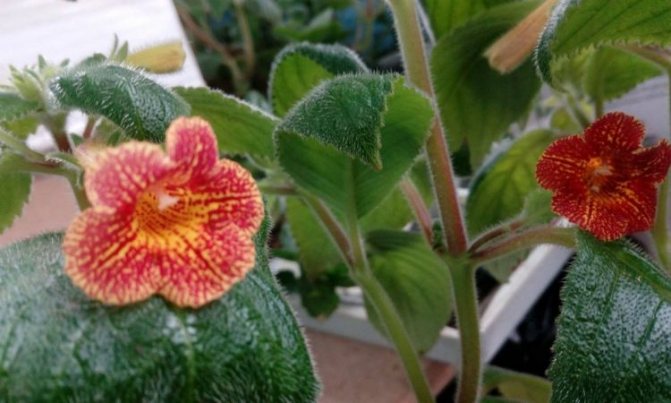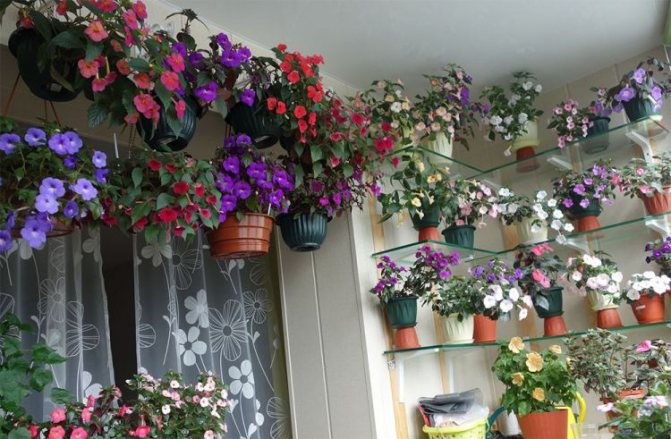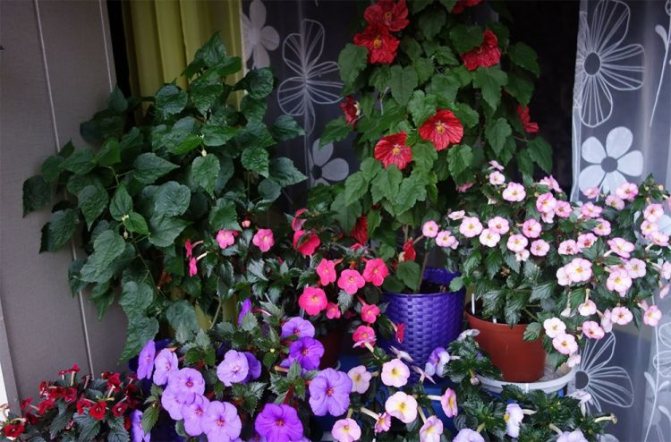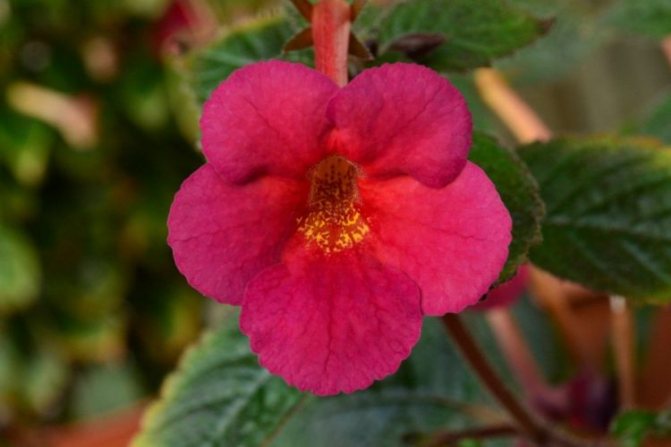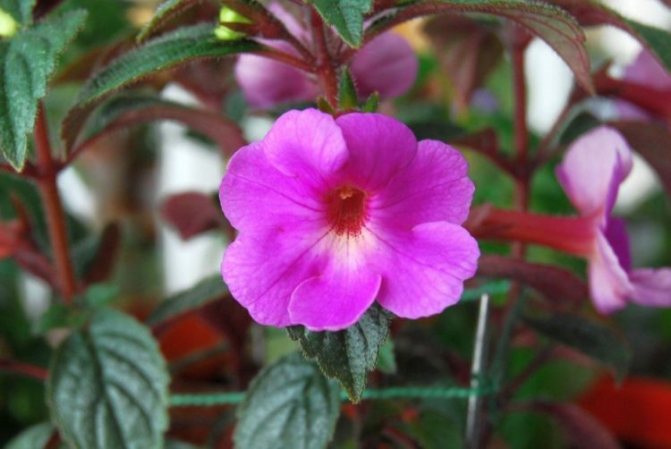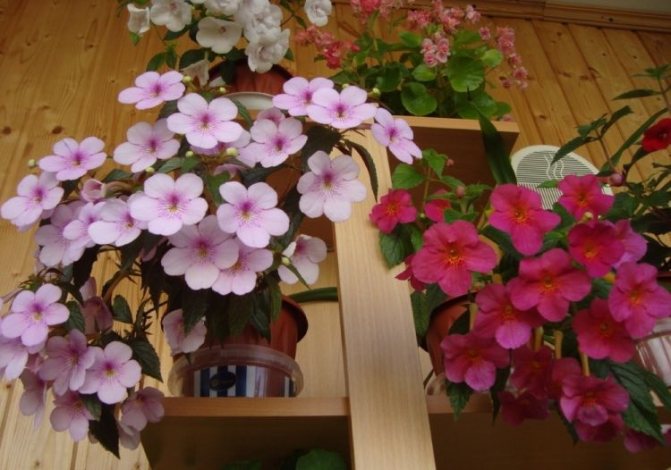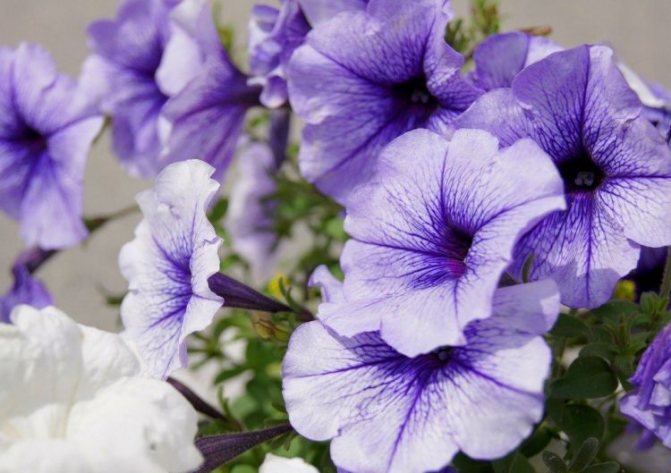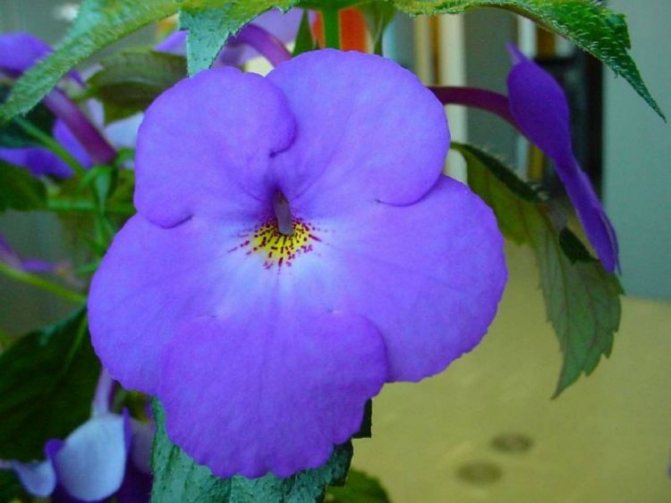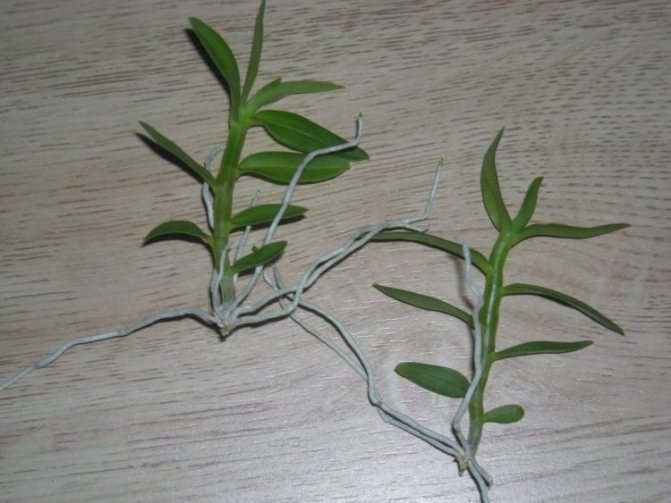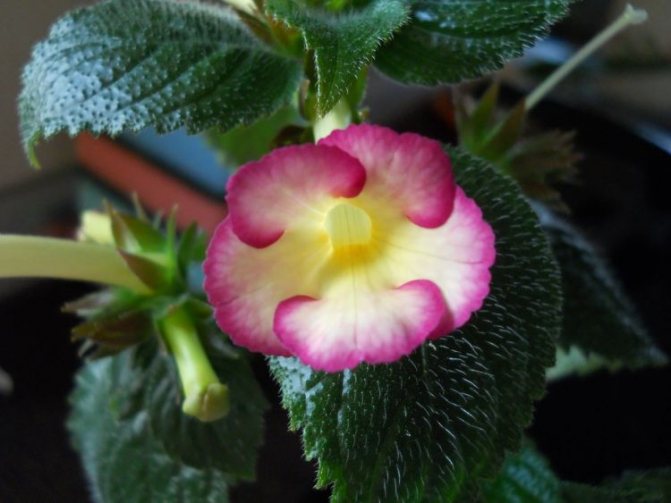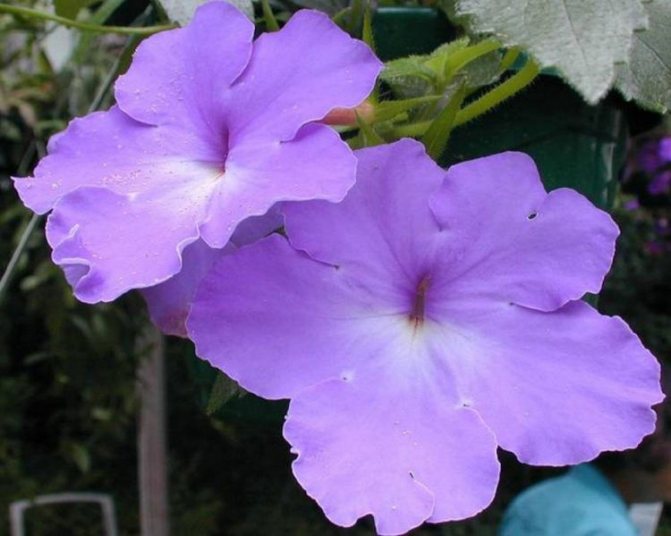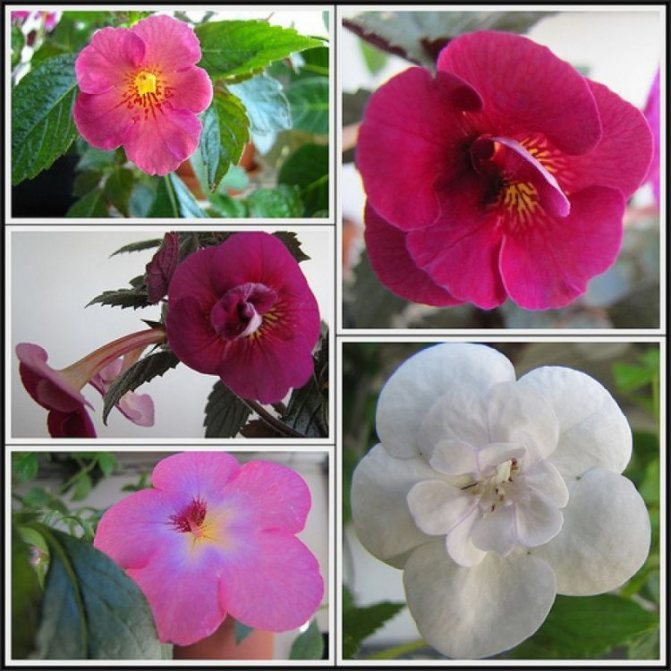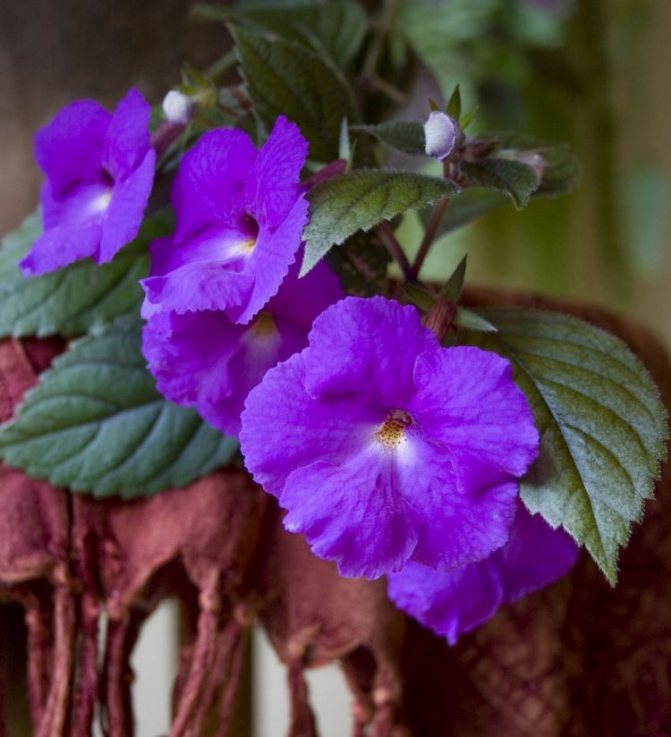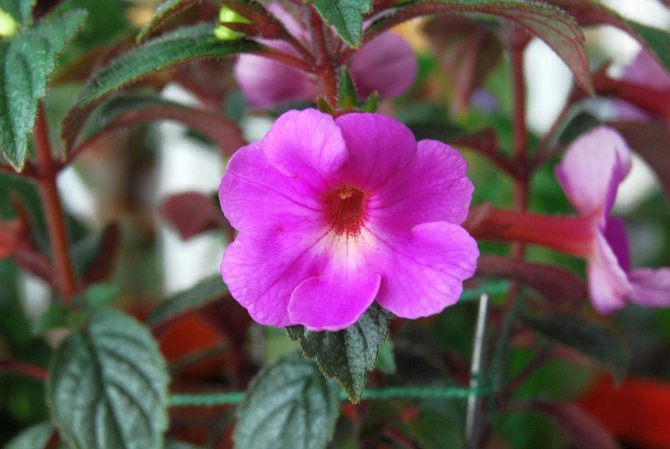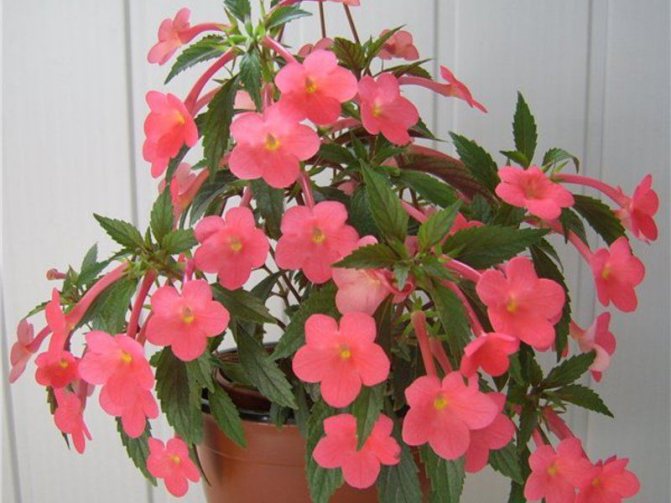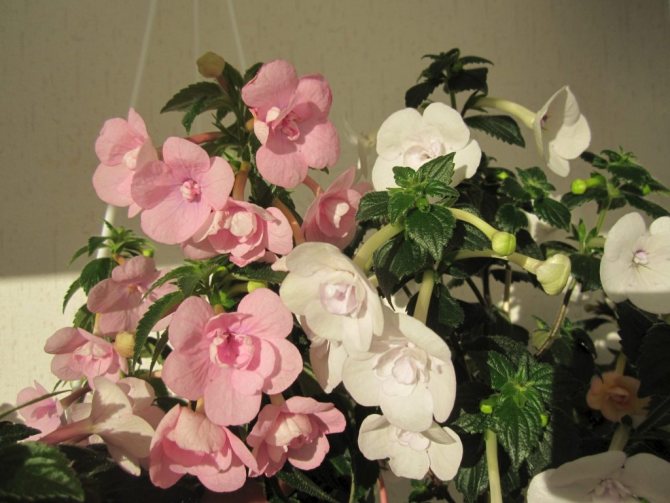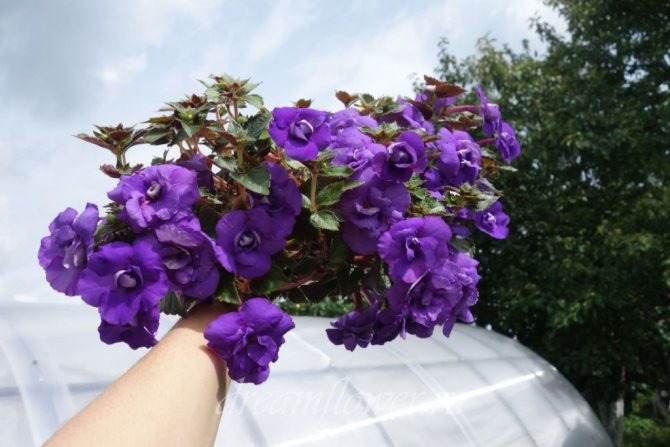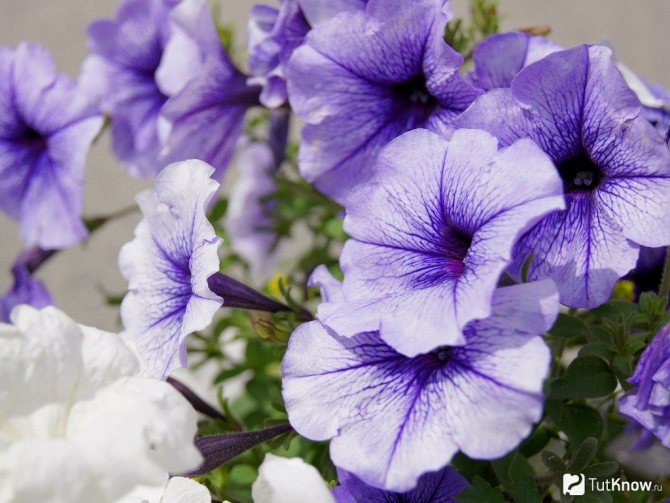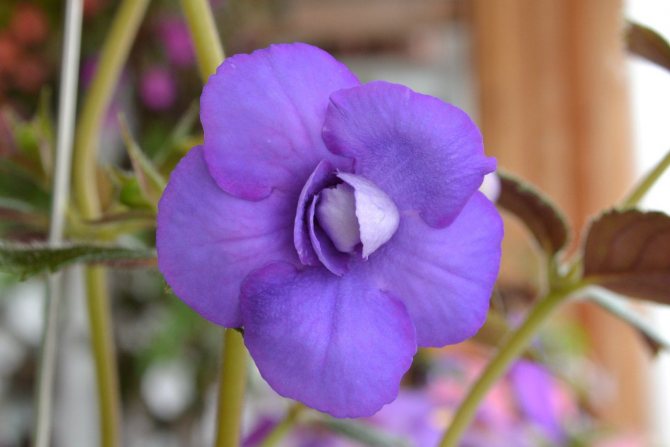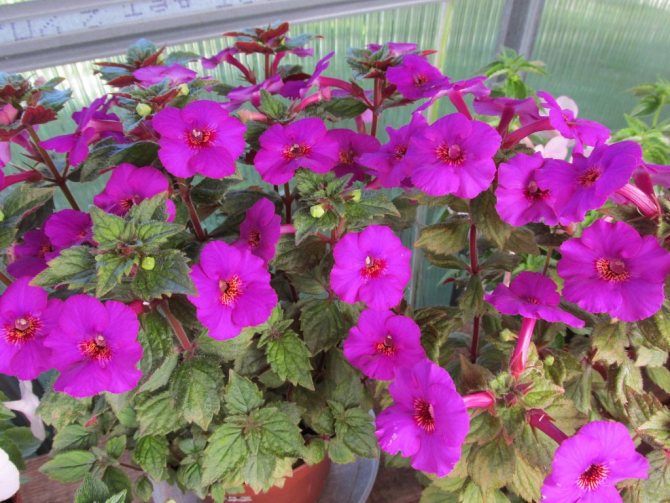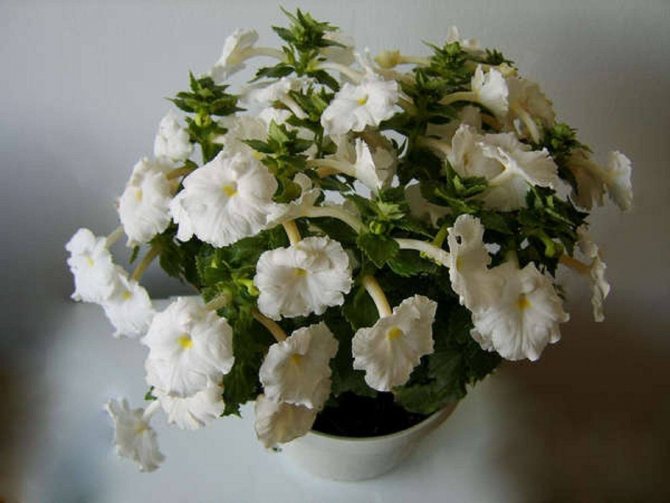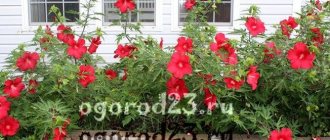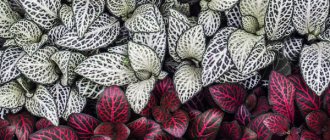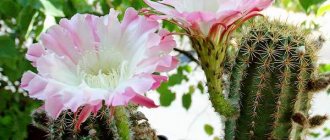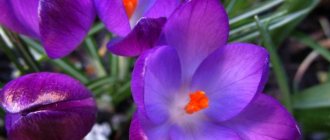Dear flower growers and color lovers, today our article is about the beautiful achimenes flower. The number of fans of this wonderful plant is growing every year.
Its abundant inflorescences, with bright attractive flowers, and luscious green leaves look very elegant. Ahimenes is ideal for decorating balconies and apartments because it blooms for a long time, magnificently and stunningly beautiful.

Today in the article:
Features of the view
In the description of achimenes, you can find that the stems have a lot of branching. They can be both erect and creeping. The leaves are quite soft, may have a slight edging and jagged edges.


The flowers are like bell flowers. They are brightly colored: yellow, red, white. May be striped or have spots on bells.
The achimenes plant is quite unpretentious, but it should be protected from a sharp change in temperature in the room, as well as dry and cold air should be avoided, and kept away from drafts.
With the onset of the autumn period, achimenes at home stops growing. Despite the fact that the leaves may dry out completely, the plant remains alive. It hibernates.


As soon as spring comes and the air temperature rises, the plant will germinate.


How to dig up rhizomes and prepare for storage
Ahimenez can be left in a pot without digging up the rhizomes, and in the spring he will wake up again. But if you want to save space, plant a flower in the future and get some plants, then dig them up is the best solution.
The rhizomes are easily stored dry in zip bags in vermiculite, which is no doubt convenient and compact. Thus, a huge collection of different varieties can fit in just one small box.
In addition, rhizomes in bags do not require watering at all. Dug up, folded up and forgotten. Remembered only in the spring.
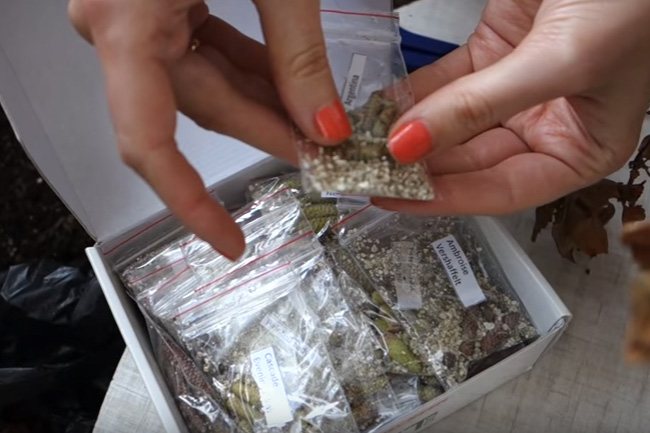

It should be noted that flower growers who are fond of Achimenes get a special pleasure from digging up rhizomes and often compare this process with harvesting. Because while the plant is in a pot, it is not known which rhizomes and how many of them he managed to grow during the period of growth and flowering.
Therefore, we can say that digging the roots of achimenes is as interesting as opening a kinder surprise.
To do this, you must first of all wait until the plant is fully ready for the dormant period. It will make it clear to you with all its appearance.
Cutting off the stems before it completely dries out is impossible, because this will affect the rhizomes, they will not have time to ripen and form as expected. Therefore, although it is not entirely beautiful, we are waiting for just this type of plant.


First of all, we cut off all the dry branches of the plant with sharp scissors.


We take out the earthen lump from the pot and examine it. In some places, you will already notice rhizomes.
Very carefully, with our fingers, we begin to remove the excess soil and break the earthen lump. Usually, all rhizomes are concentrated in the upper and middle part of the pot.
The rhizomes of achimenes are quite fragile, but if you break one or more, it’s okay. Ahimenez will sprout from each part in the future. This is how rhizomes are located. They fall off on their own, or you can carefully pull them off.


The found crop is laid out in some container. Rhizomes may look different depending on the variety. They are long, short or round and super-small at 0.5 cm. One variety in a pot can have roots of completely different lengths.
If the crop turned out to be small and unsightly, do not be discouraged, all the same, all the resoms are suitable for future germination, and perhaps next time you will be more fortunate.
Then the roots are dried for several days at room temperature, as a result of which the excess earth easily flies off them and they become clean. You do not need to wash them.
We prepare our own separate bag for each variety. We pour vermiculite into it.
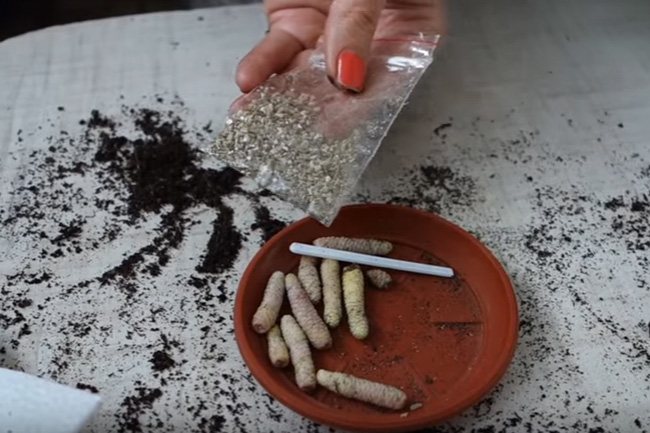

Rhizomes are placed in a bag and stored in a box with a lid to exclude the access of light. The box is placed in a dark, cool place, the storage temperature of the rhizomes of Achimenes in the winter is 15-17 degrees.
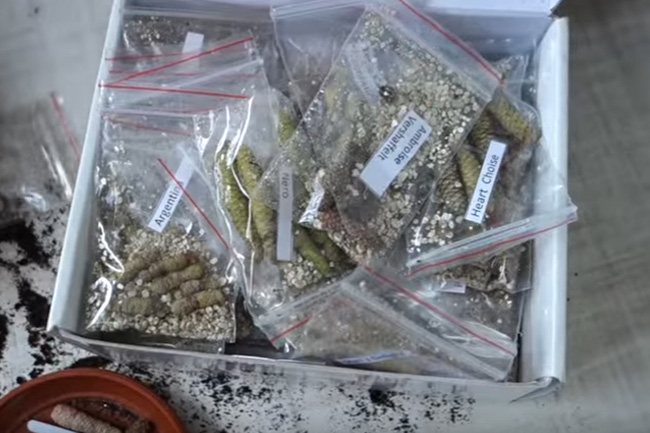

Once every few months, the condition of the rhizome must be checked. Does the condensate accumulate inside the bags - it must be removed, the bag must be opened and ventilated.
Are there any signs of fungal diseases on the rhizomes: mold, darkening, rotting. If you find something similar, cut off the affected areas and treat the rhizome with antifungal drugs such as Fitosporin (according to the instructions), then dry and pack again.
How to store achimenes properly in winter
It is best to leave for the winter hibernation in a dark place where the cool temperature will remain.


Do not forget to periodically moisten the pot along the edge with water, and also check the condition of the rhizomes. Periodic inspection will help avoid rotting and dryness during hibernation.
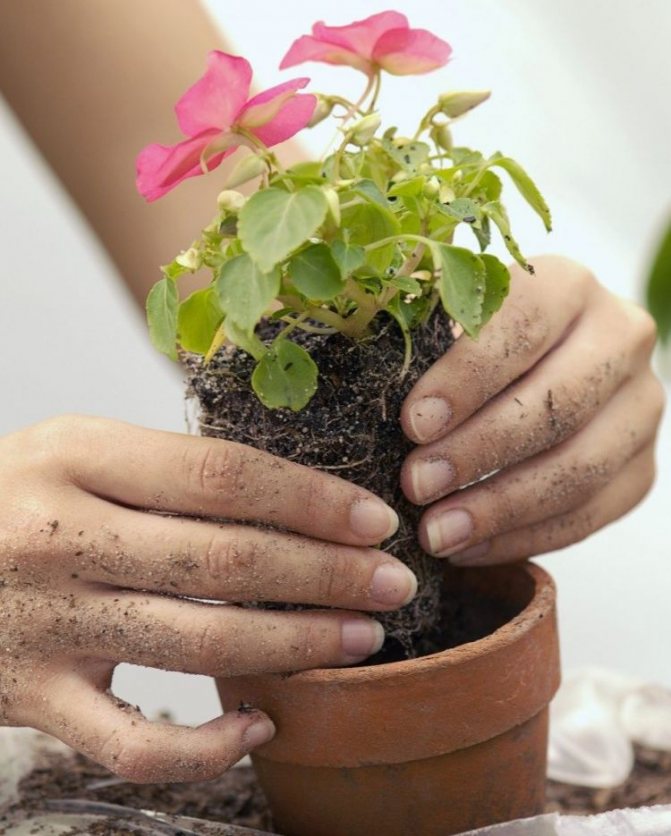

Preparation for wintering
How is Ahimenes going through the winter? Caring for him in the winter involves the implementation of several points:
- dried shoots are cut off at the base so that only formed rhizomes remain in the pot;
- vases with rhizomes are stored until spring in a cool dark place at a temperature of + 15-18 ° C;
- once a month, an abundant watering of the soil is carried out.
That's all the tricks of the beautiful achimenes plant. For many, caring for it may seem painstaking, but in fact, growing any indoor plant always requires special attention. And Ahimenes is no exception to the rule, growing it is a pleasure for a true amateur florist.
Lighting
Despite the fact that the flower is very fond of color - remove it from direct sunlight. If the plant is kept constantly in the shade, the stems will be long and bare, and the flowers will not be so bright. All varieties of achimenes equally dislike direct sunlight.
Ahimenes varieties with photo
Let's admire these lovely flowers. The names of the varieties are signed on the photo:
Now that you've learned all about Achimenes, you shouldn't have any problems growing them. And we hope these wonderful plants will decorate your homes soon.
38
Temperature
Try to keep the temperature above +20 degrees Celsius during the growing season. Avoid drafts and sudden temperature changes. If the temperature is constant in summer, the plant can be kept on the balcony.
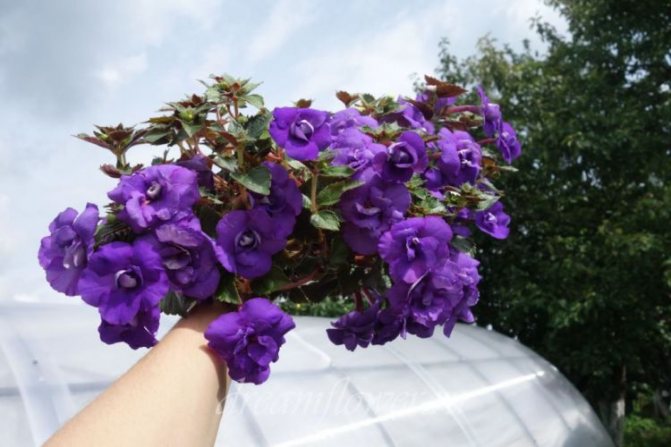

However, as soon as the temperature drops at night, take the flower indoors. The permissible temperature regime during hibernation is about 15 degrees.
A bit of history about the origins of our fluffy bell
It is likely that Achimenes is the name of some character in myths in the writings of the younger Pliny.He described this flower as a flower with magical properties. In the wild, Achimenes can be found in America, but only one of its known species - Achimenes erectus grows in East India. European researchers first mentioned this handsome man at the end of the 17th century. The flower was introduced to Europe from the island of Jamaica in 1778. The flower has become more common in botanical gardens since the 19th century.
Between 1838 and 1850, scientist Hartweg of the Royal Society of London deliberately searched for new species of this plant in Mexico and America. The flower was soon popularized in Western Europe. Almost immediately, they began to develop new varieties of it. In 1848, the breeder Backhouse was certified thanks to his Venusta hybrid.
Until 1910, many varieties of this beautiful plant had already appeared, but not all of them have survived to our time. But in recent years, many new cultivars of achimenes have been received, which is already unrealistic to list them. Not so long ago, one famous Achimenes was the most common cultivar with purple flowers.
Later, our growers began to breed plants with flowers of various colors. Of the newest varieties, one can single out those that were bred by the Romanian agronomist Serge Saliba, who created more than 200 species of this plant. Of the varieties that he received, there are those that are distinguished by unsurpassed beauty and have an original look. It was this breeder who bred the popular yellow varieties, for example, Yellow Fever. There are also novelties with flowers that change their color, mottling, there are spotty or with smoothly shifting tones.
Many amateur flower growers admire white-flowered varieties, for example, Doudle Picotee Rose. A separate branch of selection is the creation of compact, branching varieties that do not require special formation.
Land
In order for the plant to grow well, it is necessary to take a mixture of loose soil: three parts of leaf, two parts of sod land and one part of sand.
The addition of peat soil or humus is allowed. A prerequisite is good drainage so that there is no stagnation of water in the pot.


Transfer
When buying Achimenes, you should remember that you need to transplant the plant in late winter - early spring. Later transplanting requires a long adaptation period, leading to a lack of flowering.
Before planting a bush, it is necessary to remove the rhizomes from the pot, inspect, remove damaged parts. If the rhizome is very large, it is desirable to divide it. The old soil is depleted, you need to prepare a new, fresh substrate. Drainage is laid out at the bottom of the pot, soil is poured with the addition of charcoal, a rhizome is planted, and compacted well.


Rhizome division
Transplant
If necessary, a transplant is done in February after the rest period ends. To do this, it is necessary to lay the rhizomes in a horizontal position and sprinkle with a small half-centimeter layer of the substrate.


It is recommended to cover with foil until the first shoots appear after hibernation.
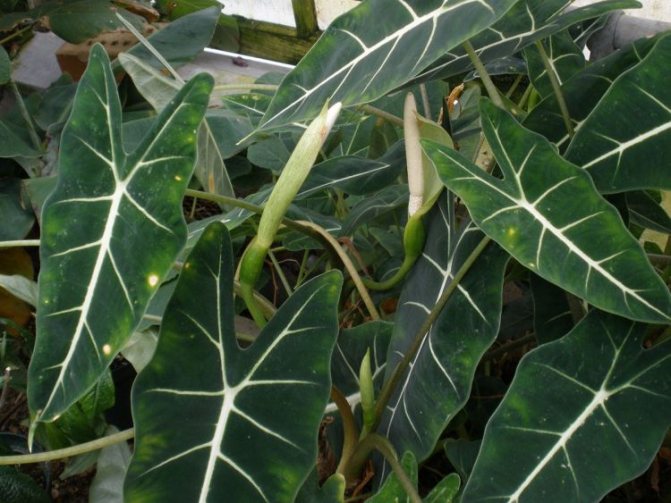

Alokazia - 105 photos of cultivation, types of plants, care and decoration options with a flower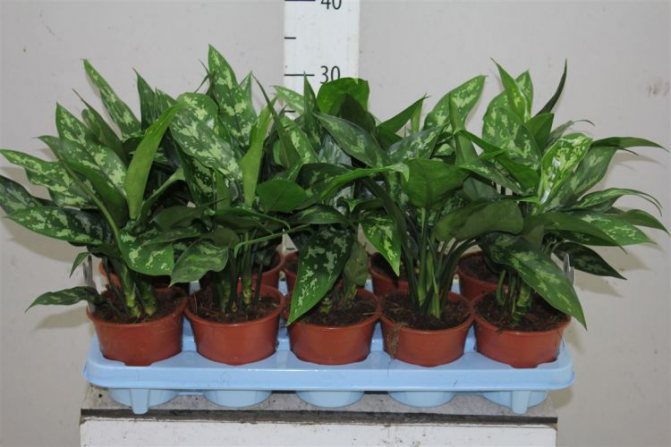

Aglaonema: varieties, secrets of growing, types, varieties, content and nuances of use (95 photos)
- Aspidistra - tips for planting, care, reproduction and use in the interior (110 photos and videos)
Breeding and transplanting tips
Planned plant transplantation is carried out annually in spring. It is performed in February - March, after hibernation.
Advice! A transplant can be done when the Achimenes have grown painfully and they need a larger pot. In this case, the soil dries quickly, the plant dries up and flowers fall off.
You can move a flower to a new place by moving it. To do this, you need to water the flower, taking it out with a lump of earth.Add earth to the pot in which you will transplant the flower, do not forget about drainage. The transplanted achimenes needs to be watered. The plant, after transplanting, feels quite well and blooms. The transshipment should be done when summer ends, since from that moment the growth of the plant stops, and it is completely ready for winter.
Fertilizers
You can feed the plant twice a month during their growth and flowering period. After the flower has been transplanted, it is not recommended to fertilize it.


During transplantation, in order to prevent decay of rhizomes, it is recommended to rinse them in a weak solution of potassium permanganate. The flower can suffer from aphids, mites and mealybugs.


Reproduction of achimenes
This plant has several methods of reproduction. Let's look at each of them and then we will understand which ones are better to use. If desired, you can combine these methods to achieve the best result.
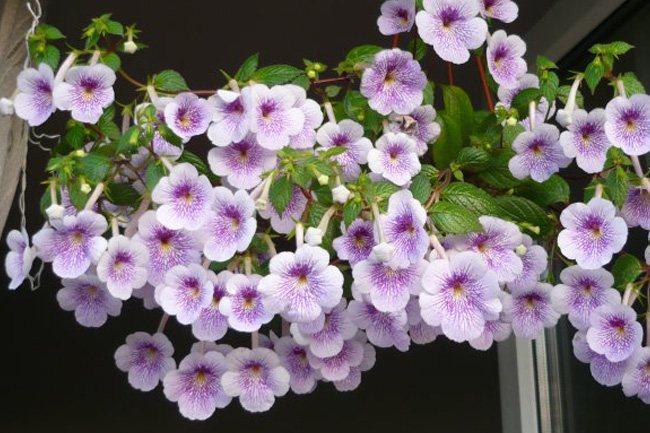

Reproduction by rhizomes
You have already seen the most popular method. This is reproduction by rhizomes. This is the safest and fastest way to get multiple plants in just one season. After all, the rhizome works on the principle of a potato tuber: you plant one or a part, and you get several, usually from 6 to 10 pieces (depending on the variety).
Moreover, this method does not require any effort from the grower - the roots are formed independently. In order for them to be more and they are of good quality, you just need to provide the plant with a container that is spacious enough in width and good care.
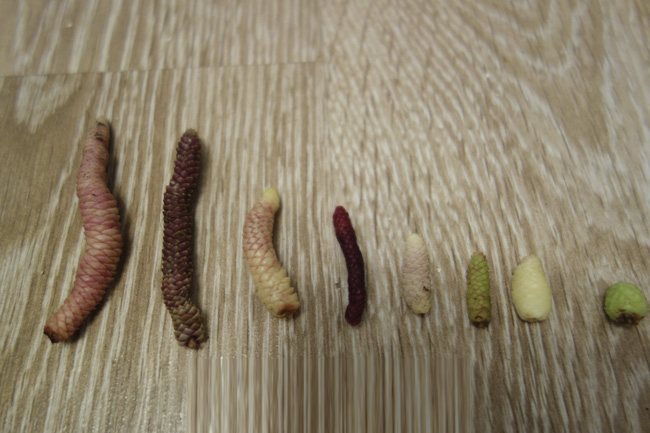

Reproduction by air rhizomes
Not all varieties of achimenes can please us with airy rhizomes, but nevertheless there are some in nature and we need to talk about them. Their function is the same as that of the basal ones.
Sometimes they form like this, on the stems. You don't need to rip them off right away. We harvest only after the stem has dried out. Aerial rhizomes can be stored in bags in the same way and planted in the ground in spring. This will make a wonderful plant.
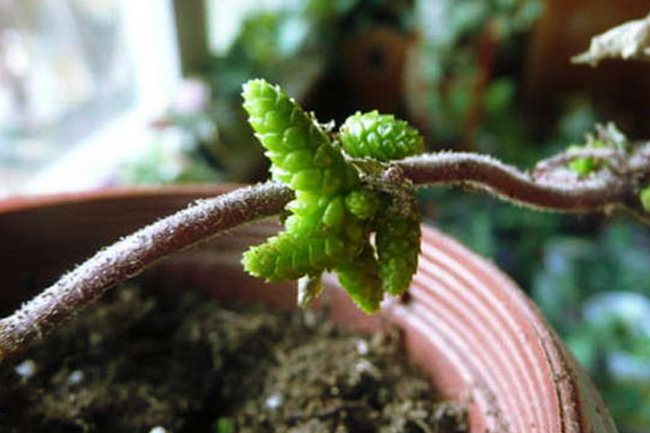

Propagation by cuttings
Achimenes is easily rooted in this way, as well as any plant with non-grinded stems. The apical stalk is selected; it can be quite small.
With a sharp razor or knife, it is cut off and placed in the ground under the greenhouse for rooting. It also takes root well in peat tablets.
Cuttings are made before the beginning of flowering of the plant.


Leaf propagation
This plant can indeed be propagated even by leaves. This is also a good way to get multiple plants at once.
With a sharp knife, cut off a leaf of achimenes with a shank and place it in the ground and in a greenhouse, like a violet leaf. In a couple of weeks, the first roots will appear. When propagating achimenes by cuttings and leaves, it is necessary to maintain a sufficient level of soil moisture.
However, when planting leaves in spring, they will bloom only for the next season.
Their first summer will be spent on the formation of root systems and rhizomes. In winter, it will be prudent not to disturb the rooted leaves or dig up their rhizomes, leave them to winter in pots.
In the spring, when the achimenes hatch from the leaf, he will need to be transferred to a larger pot. And this summer he will delight you with flowering.
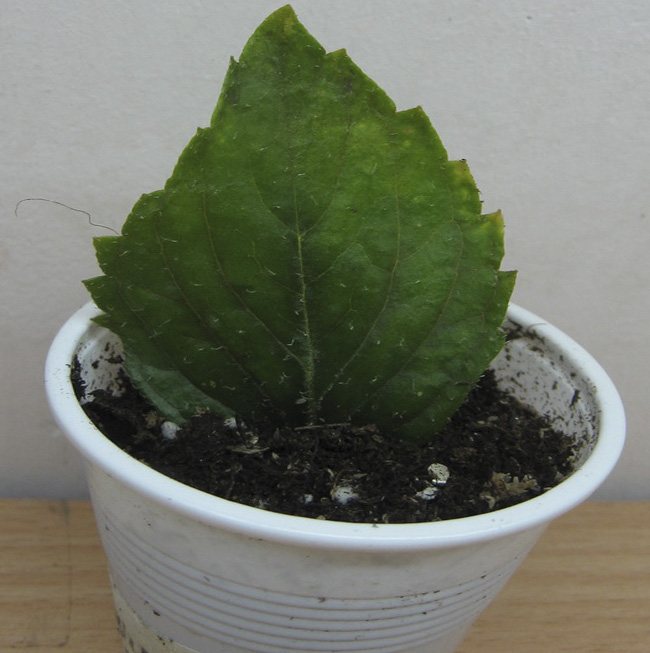

Photos of achimines


Washingtonia: species with photos and names, a brief description of the cultivation, useful properties. Detailed instructions on how to care at home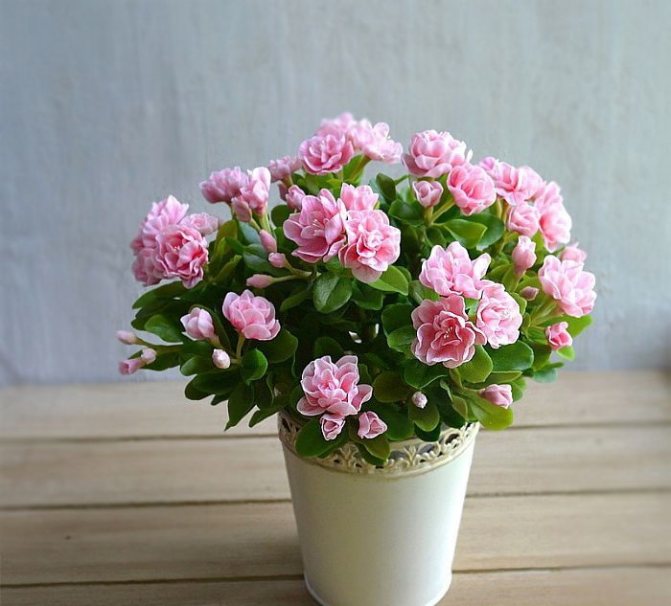

Azalea: description, types and varieties, breeding methods, planting. Rules of care, watering, plant formation, feeding. Diseases and pests. 70 photos of blooming azaleas
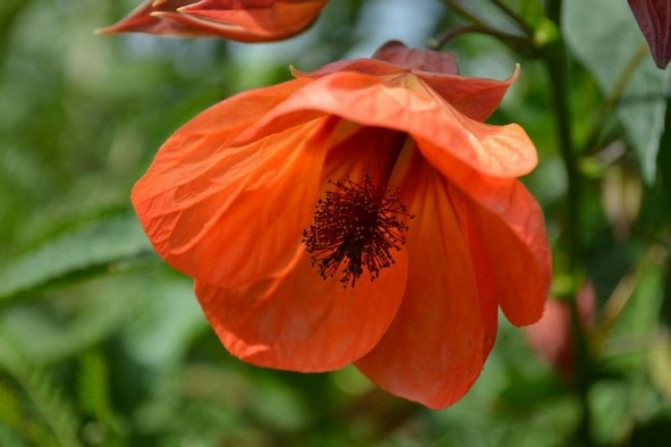

Abutilon - types, growing rules and home care. Diseases and pests, planting and reproduction of "indoor maple"
Read: Anthurium - options for application in design, the nuances of care, cultivation and transplantation (105 photos and videos)
Did you like the article? Please share with your friends 

0
Write a comment
New design
Provence curtains - design ideas and an overview of the ideal combinations of curtains in a rustic style (110 photos and videos)
Minimalism in the apartment - interior ideas and design options. Tips for applying different styles (100 photos)
Kitchen-living room 20 sq. m. - design ideas, interior design options and an overview of the most stylish combinations (110 photos)
Living room decoration - tips for choosing colors and materials. An overview of the most beautiful living room design ideas (90 photos + video)
Common varieties
- Blue Star is a large flower with a blue-violet corolla, serrated and wavy petals. The plant is erect.
- Peach Cascade is a peach-colored plant. They brought it out quite recently - in 2009. The color will depend on the light, it does not fade in the sun.
- Amie Saliba is a small plant with very brightly colored flowers.
- Ampel Achimenes have a wide variety of varieties, are distinguished by a drooping stem, this variety is inherent in dense flowering and will greatly decorate your interior.
- Glory is a small bush, the leaves of which are unsaturated green color, and the flowers are scarlet, in the center with a yellow speck and brown strokes. Blooms profusely.
- Double Pink Rose blooms profusely and for a long time. It has narrow leaves, and its flowers are double, pink.
- Purple King - this variety is very popular, although it was bred for a very long time. It has a purple color and erect stems. It blooms approximately - from spring to late autumn.
- Sauline - small yellow flowers that have a finely serrated edge. This plant is erect.
- Lavender Fancy are medium, lavender with a speck of cream and eccentric brown stripes. It has light green leaves and a burgundy stem.
- Peach Blossom - pink and fuchsia speck. Foliage in two shades - dark green, smoothly turning into a burgundy shade. Does not require special care and attention, blooms profusely.
Ahimenes: specific features and differences
The colorful flowers of achimenes are very similar to their relatives the violets and gloxinia. Both those and others bloom throughout the warm period and delight the hostesses with a variety of colors. From the Greek language, the name of the flower is translated as "the one who is afraid of the cold."
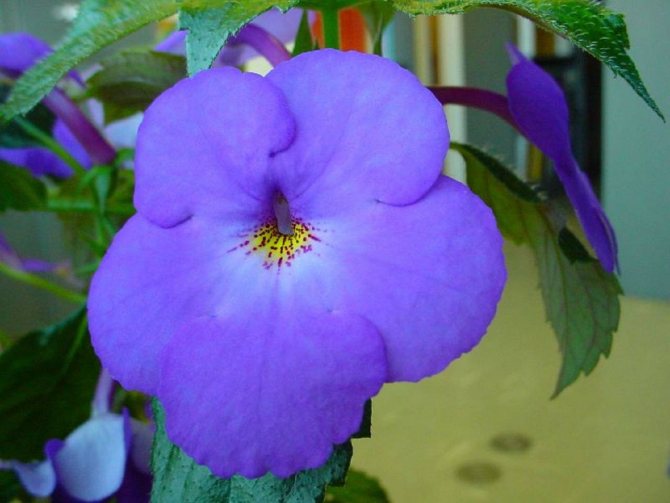

The variety of colors is simply amazing - red, purple, pink, blue, yellow, etc. This allows you to create a real flower garden, having at your disposal only one type of this plant.
Achimenes petals can also differ in non-standard design and shape. In addition to the classic oval shape, there are plants with round, double and carved jagged edges.
The height of the Ahimenes is from 20 to 60 centimeters. The plant is bushy and ampelous, depending on the species characteristics.
The roots of the flower are represented by oval tubers, reminiscent of an alder cone. They are located in the top layer of the soil, so it is so important not to damage them.
General description of Achimenos
They grow epiphytically - leaning their weak, flexible stems against the support plant. They like moderate temperatures, so in nature they prefer the shade of gorges, river terraces, and grow near waterfalls. In America, they can be found at an altitude of 1500 m above sea level.
Ahimenes accumulate water reserves and nutrients in massive, covered with scales, rhizomes. Thanks to this root modification, plants survive in areas characterized by alternating dry and wet periods. Flowers are represented by bisexual five-membered calyxes adapted for cross-pollination by bats, hummingbirds, bees and other insects. The fruit is a capsule.
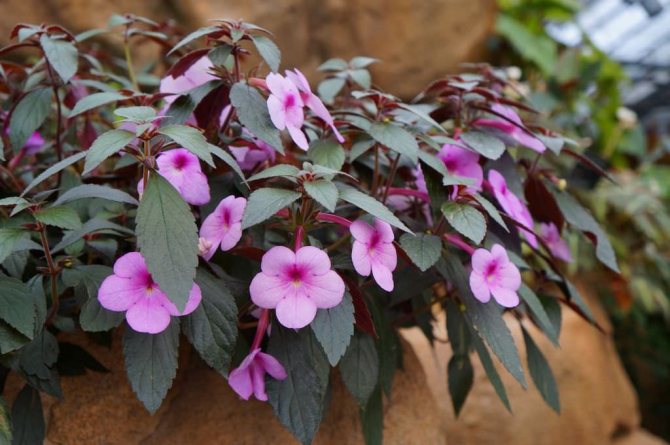

Home care
To grow a healthy and abundantly blooming achimenes, you need to create comfortable conditions for him.
Location and lighting
The culture is very light-requiring. Therefore, special attention should be paid to lighting. The flowerpot should be placed as close to the window as possible. But the flower should not fall under the direct rays of the sun. During the period of sunshine, it must be shaded. In the summer you can take Ahimenes outside. But avoid exposure to drafts and precipitation. With a lack of lighting, the shoots of the plant will stretch and become bare.
Soil and drainage
The flower needs a loose, nutritious soil. For all types of achimenes, a substrate for violets or cyclamens is suitable.
You can prepare the soil mixture yourself from:
- leafy land (3);
- peat (1);
- sand or perlite (1).
You can mix it with a small amount of sphagnum, charcoal, crushed shellfish. The bottom of the container for planting must be lined with a drainage layer, which should be 1/3 of its volume.
Planting and transplanting
Achimenes needs to be transplanted into a new pot every spring. Carefully remove the tubers (rhizomes) from the pot, carefully examine them. For planting, select only healthy and resilient specimens. Rhizomes with mold and dry discard.
Take a wide and shallow pot. Lay drainage in it, then - a thin layer of soil and sand. Drizzle with warm water. Spread the tubers over the surface at a distance of 2 cm from each other. Sprinkle on top with soil 2 cm thick. Cover the pot with foil and put in a dark place. Before sprouts appear, do not water the substrate, but be sure to air the plantings. When the leaves appear, rearrange the flowerpot to a lighter place.
Achimenes of different varieties cannot be planted in one pot. Each of them has its own development cycle, and, accordingly, the conditions of care. After buying a flowering plant, it is better to refuse to transplant it for a while.
Video - instructions for transplanting Ahimenes using the transshipment method:
Temperature
For normal development during the growing season, Achimenes is kept at a temperature of + 22..24 ° C. In winter, the flower needs peace. The temperature regime should be lowered to + 14..16 ° C. You can not resort to a sharp drop in temperature. This can be done gradually. The root system must adapt to a comfortable wintering period.
Air humidity
Since Achimenes comes from a tropical climate, air humidity is of great importance to him. It should be around 60%.
A warning! You can not spray the crop to increase moisture. Water drops have a detrimental effect on the appearance of the leaves. Spraying the air around the plant is allowed. You can put a flower pot on a pallet with wet expanded clay.
Watering
When achimenes is actively growing, it needs regular hydration. Water is used for irrigation warm, well-separated. Pour it only at the root, avoiding drops from falling on the leaves. During the dormant period, watering is stopped altogether.
Top dressing and fertilizers
The culture needs regular feeding during a period of active growth every 1.5-2 weeks. Fertilization can be started no earlier than 1.5 months after the end of the dormant or transplant period. Complex mineral fertilizers for flowering plants (Agricola, Pokon, Etisso) are suitable for achimenes.
Flowering period
The first flowers appear on the bush in late spring. They represent a long narrow corolla with 5 folded petals. The diameter of the flowers is about 3-6 cm, depending on the variety. The colors can be varied (red, yellow, white). Achimenes blooms for a long time, it can last until the end of September. Sometimes the culture blooms 2 times a year.
Pruning
To force the bush to branch more, you should pinch young shoots near 2-3 leaves. The disadvantage of this procedure is that the plant blooms a little later than usual. To stimulate abundant flowering, you need to remove wilted buds in time.
Growing reviews
I first met this plant about 25 years ago, it grew at our work, but no one knew where "he came from and what his name is." Over time, I found out the name of the stranger - Ahimenes. Since then we have not met, for some reason they have not sold it in any flower shop. And only in January of this year, I found an online store where rhizomes (rhizomes) of varietal Achimenes were sold. I planted rhizomes in pots in February (planting depth about 2.5 cm), waited a long time for tiny sprouts (appeared in April), slightly moistening the soil. When it got warmer, I took it out onto the balcony, protecting it from the scorching sun. Flowering began at the end of May. A very beautiful and interesting flower, especially convenient for those who do not have enough space on the windowsill in winter.
Svetlana Yurievna
After flowering, I put the achimenes on the loggia and do not water it, after a while all the juices go into nodules, I cut off the branches to the ground and put them to rest, usually until the New Year. In January, I put the achimenes in a bright place, but not in the sun and do not water, somewhere in February fresh shoots appear, then I start to water a little bit, if there are a lot of nodules, I transplant in March-April.
hator
I love to plant it in pots with large plants. So unpretentious.
angel47
Rhizome nodules can be purchased throughout the year, but not through the post office, from October to May, they can be very cold during transportation.
Asio Otus
Plant differences
Ahimenes differ in the following characteristics:
- Shoots type - there are species in which they grow upward (erect), and there are those in which they droop (ampelous).
- Bush height - various species, varieties and hybrids form bushes with a height of 30 to 50 cm.
- Bud size - there are small, medium and large, reaching a diameter of 2.5 to 6 cm.
- The color scheme of the buds - petals can be pink, purple, white, red, yellow, orange.
- Terry level of flowers - petals are smooth, semi-double and double.
- Flower shape - in the course of flowering, buds are formed, rounded, long, bell-shaped.
Solution of problems
Table: why leaves curl - consequences of care errors
| Problem | Cause | Elimination |
| Brown buds | High air temperature | Rearrange to a cooler place |
| Brown spots on the leaves | Watering with cold water | Use warm settled water for irrigation |
| Leaves dry and fall off |
|
|
| The sheet plate rolls up and dries |
|
|
| Shrinking flowers and reducing their number | Lack of nutrients | Adjust the feeding mode |
| Scattering of buds and leaves, dry brown spots | Sunburn | Shade from direct sunlight |
Table: pests and diseases of achimenes and their treatment
| Parasite | Signs | Prophylaxis | Treatment |
| Spider mite |
|
| Insecticide treatment in accordance with the instructions (Karbofos, Actellik, Inta-Vir, Fitoferm) |
| Aphid |
| ||
| Whitefly |
| ||
| Thrips |
| ||
| Rot | The leaves turn brown, have a gray coating, die off |
| Watering with drugs against phytopathogenic fungi (Abiga-peak, Oksikhom) |
The rustic beauty of half-forgotten Achimenes
Relatives of the beloved Saintpaulia Achimenes in the last decade have almost disappeared from the shelves of flower centers. They are often referred to as "grandmother's" plants, underestimating the beauty of both greenery and flowering. It is for the sake of the latter that Achimenes is grown. At their peak, they resemble chintz fabrics, thanks to the bright single flowers that dot the cushions of greenery.
The status of a flowering plant does not make Achimenes capricious: it is a hardy, undemanding, but somewhat unusual plant for lovers of romantic classics.
The Ahimenes, unlike the closest relatives of the Saintpaulias, do not belong to African endemics. This plant came to us from the South American flora, having lost in the process of domestication and the ability to develop quite aggressively, and have a larger size. True, Achimenes does not belong to the capricious tropical plants, living mainly in the subtropics and being content with average humidity.
The name Ahimenes presumably received in the days of Ancient Hellas, with the light hand of Pliny, who gave the name of the "magic plant" (according to another version - "afraid of the cold"), but disputes about the origin of the name are still ongoing. Despite its rather striking appearance, the popular nicknames of Achimenes are not so popular, although many people like to call this plant a “friendly family”.
Ahimenes are mistaken for traditional rhizome herbaceous perennials. They have a very unusual rhizome, develop in the form of scaly-pineal, elongated rhizomes, somewhat similar to caterpillars, and thanks to them differ from any other representative of the Gesneriev family.
Superficial roots require the correct selection of growing containers. Tuberous rhizomes are light, up to 7 cm in length. In height, the bushes of Achimenes will not exceed 20-30 cm. Conventionally, these plants are divided into two varieties - ampelous forms with drooping shoots and upright or bushy Achimenes, which are sometimes presented in catalogs as upright achimenes.
They differ only in the form of growth and flexibility of the shoots. Drooping, thin, unable to withstand the weight of leaves and inflorescences of shoots in the former and slightly stronger, but not rigid, upright-growing ones in the latter. Ahimenes are easily formed, allowing, thanks to easy pruning, to control the size and shape of the bushes, but by nature they are quite thick and lush, they stretch only in extremely inappropriate conditions. In length, shoots of achimenes can reach 60 cm.
The foliage of Achimenes is simple, with its wrinkled, generously veined surface and its general shape similar to nettles. The softness of the leaves, pleasant to the touch, is combined with intense dark, most often cold-emerald shades of color. A reddish tint appears on the underside of the leaves.
In some varieties, the leaves flaunt a purple color, almost all Achimenes have a beautiful, pleasant edge on the leaves and shoots, surprising with long hairs. Pointed tips, coarse-toothed edge, opposite arrangement, smaller internodes at the tops of the shoots allow Achimenes to create the effect of a cushion of greenery. The fineness of the leaf blade and the glossy sheen of the surface are often unusual.
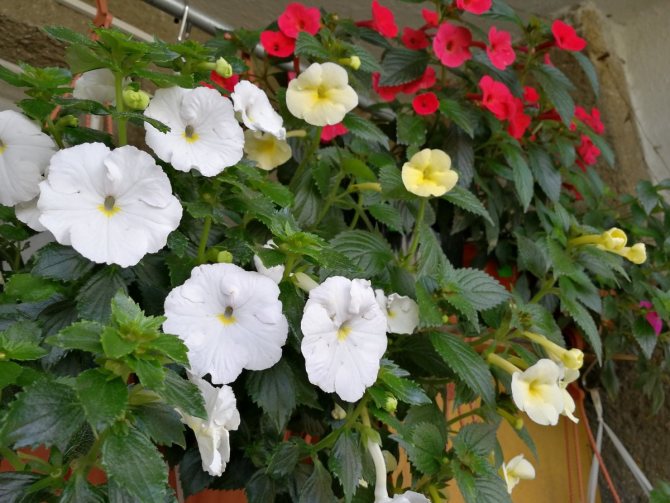

Ahimenes blooms profusely from July to September, although many hybrids are capable of blooming for more than three months. <>
How and when does achimenes bloom?
The flowers of achimenes really look rustic, but once you look at them, the original asymmetry, and the unusual structure, and beautiful details will become noticeable. The narrow tube turns into a flat bend with five round lobes-petals closely overlapping each other, in which the smaller sizes of the two upper petals are not always striking and appear differently in varieties.
The diameter of the corolla can reach 5 cm. The pharynx is always contrasting, most often yellow, with original specks and strokes that are almost invisible from a distance, but adorn the plant. For the Achimenes, the flowers are mostly solitary, sessile in the axils of the leaves, although in some new hybrids the flowers are collected in loose brushes.
The Achimenes color range includes the purest shades of pink - watercolors, easily recognizable, vibrant colors associated with flowering classics. Candy pink and raspberry, salmon and scarlet, lilac and purple in different varieties are striking in their purity. Today, two-tone varieties of achimenes are very popular, although the plant is associated, first of all, with flowers of pure and bright acrylic colors.
The flowering period of Achimenes traditionally falls on the hottest summer months. Most varieties delight with flowers from July to September, although many hybrids are able to bloom profusely for more than three months. Each flower lasts only a few days, but the rate of release of new buds fully compensates for the rate of rapid flowering.
Top dressing
Complex mineral fertilizers begin to be applied a month after the first shoots have appeared and continue with an interval of two weeks until the end of flowering. The first top dressing is focused on the growth of leaf mass (fertilizer for deciduous), and with the beginning of flowering, fertilizers for flowering plants begin to be used.
Ahimenes "Summer Sunset"
Red and white bush of Achimenes "Nero"
Which pot to choose for achimenes
The roots of achimenes are located on the surface of the soil, so there is no need for spacious pots. The plant will feel great in a wide and shallow container.
The lower part of the pot is covered with gravel stones or small fragments of brick. The second layer of earth is a mixture of sand, turf, leafy earth and charcoal.
The roots of the plant do not need to be "sunk" into the ground. It is enough to sprinkle them with a small amount of earth.
Advice! After transplanting, the plant must be placed in a warm place until new leaves appear.
Plant diseases and pests
With mistakes in care, the plant can get sick and be affected by harmful insects. Of the diseases, root rot is the most dangerous for achimenes. It develops under excessive watering and cold temperatures. If the lesion is not strong, then you can remove the damaged areas, sprinkle the cuts with crushed charcoal and treat with a fungicide, for example, "Fundazol". Then you will need to transplant into a new pot and soil.
Of the parasites, the flower is affected by aphids, spider mites, mealybugs:
- Aphids reproduce very quickly... When it gets on a plant, it drinks juices from it, leading to its oppression and death. The insect settles under the leaves. It is very small, so it is not always possible to see it. Treatment is performed by wiping with soapy water. In case of severe infection, they resort to spraying with insecticides - "Fitoverm", "Aktellik", etc.
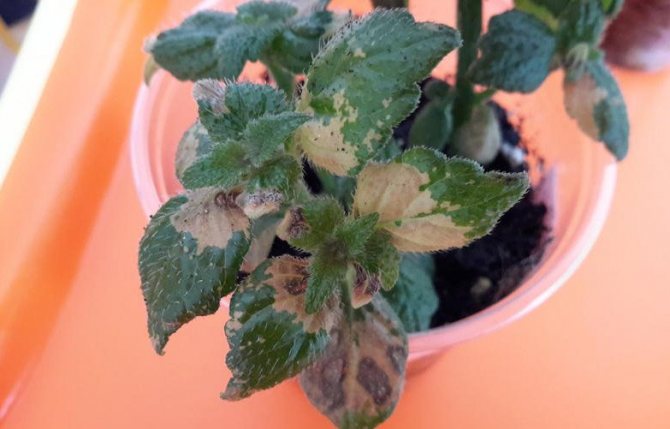

- Spider mites also suck out juices from the plant.... This is a small black or red insect that braids leaves and shoots with cobwebs. It settles on flowers that grow in too dry and hot conditions. To get rid of a tick, it is necessary to maintain high air humidity, make soap wipes, spraying with chemicals "Fitoverm", "Iskra-M", "Aktellik".
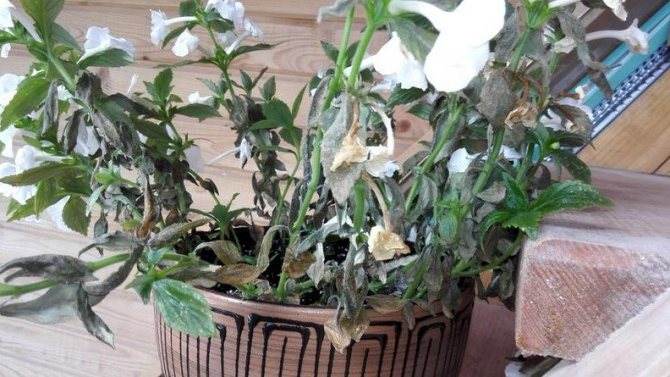

- The mealybug can be recognized by the characteristic white bloom on the plant.... In the process of its vital activity, it leaves white friable discharge. Destroy it by wiping with soap solutions, treatments with a solution of green soap, tobacco and garlic infusions, preparations "Aktara", "Biotlin", "Calypso", "Confidor", "Fitoverm".


Achimenes, in the course of numerous breeding works, differ in many species, varieties and hybrids, among which each grower can choose his favorite color and size. Akhimenes have bush and ampel forms, which allows them to be grown both on horizontal surfaces and suspended.
Recommendations from Serge Saliba
Famous Romanian Ahimenes breeder Serge Saliba shared his secrets. He advises planting rhizomes in the last decade of February. Place the rhizomes to a depth of 5 cm, no more than 5 pieces in one pot. The pots should be 16 cm in size. Serzh Saliba spends the first pinching when 2 pairs of true leaves are formed, and the stem grows to 1.5-2 cm. Pinching at this moment will allow you to get cascades of achimenes with a lot of beautiful flowers in the future, although it can delay bloom for one week. Shrub, ampel and semi-ampel forms should be pinched at least 5 times! Tetraploid specimens can be grown with one pinch, or not at all.
Flower pots should be on the sunny side from the time of planting until the first flower bud is formed. Then they are moved to partial shade. Ahimenes should be sheltered from bad weather and drafts. Fresh air is required. The optimum temperature is 23-25ºC. At 37ºC, the color of the petals changes radically.



